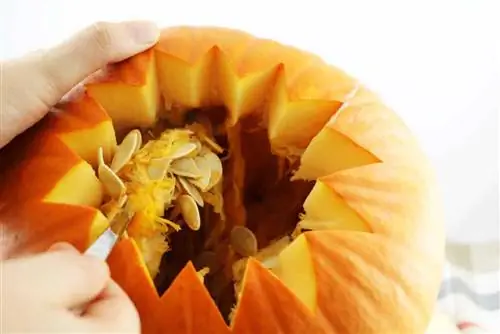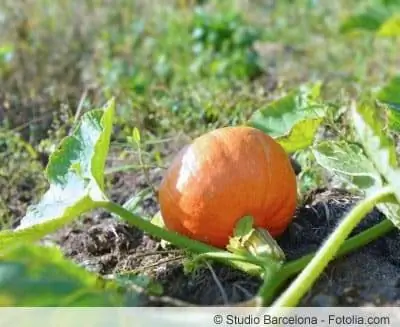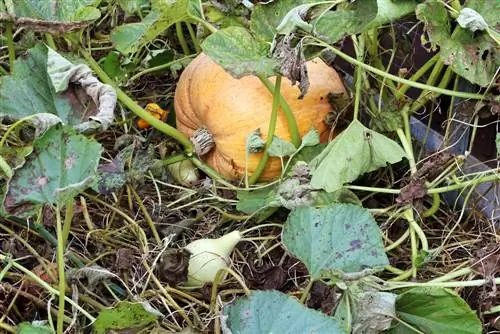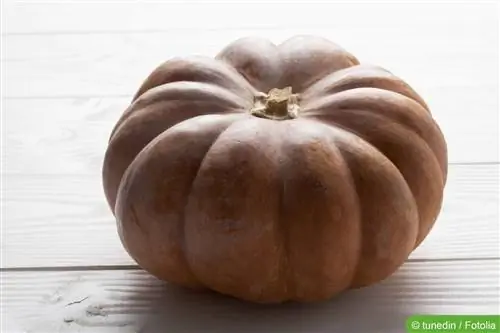- Author admin [email protected].
- Public 2023-12-17 03:39.
- Last modified 2025-06-01 06:48.
Pumpkin is one of the most popular vegetables that are in peak season in autumn. It tastes best when freshly harvested, but freezing it makes it available for the rest of the year. The problem with pumpkin is often that it tastes bitter. If this is the case, it is unsuitable for consumption. In order not to experience a nasty surprise after defrosting and the effort was not in vain, a certain procedure for freezing must be followed.
He alth hazard
If pumpkins taste bitter after thawing, this is only indirectly due to freezing. The bitter substance cucurbitacin is responsible for the bitter taste. Due to “modern” breeding, this has largely disappeared from pumpkins. However, it is often found in ornamental pumpkins. Especially when growing yourself, crosses occur between specimens that contain bitter substances and those that do not contain bitter substances. So it is still possible to buy and/or grow pumpkins with a bitter taste, although the former is still rare these days.
Cucurbitacin
Cucurbitacin is a substance whose bitter taste is stuck in the pumpkin flesh and is therefore perceived when consumed. In terms of taste, it is theoretically possible to argue about whether an affected pumpkin is still edible. What there is nothing to discuss is the he alth effect on the body when this bitter substance gets into it. The higher the concentration, the more intense/extensive the symptoms of poisoning can be. Sick people, seniors and small children/babies are particularly at risk.
Therefore:
Never eat pumpkin if it tastes bitter.
Consequences of poisoning can be:
- Increased salivation
- Stomachache
- Nausea
- Vomiting
- Diarrhea
- Water loss due to persistent vomiting and diarrhea
- For particularly vulnerable/sensitive people, possible death in the worst case scenario
NOTE:
If people who are particularly at risk have consumed bitter gourd, they should contact their family doctor immediately or call the region's poison control center. The same is advisable if larger quantities are consumed by he althy people or if the symptoms increase in intensity.
Suitable Pumpkin
As any bitter substances present increase in intensity/volume as they ripen, caution is advised with very and overripe pumpkins. If the toxin has a noticeable taste, no matter how slight, freezing should generally be avoided. For this reason, when harvesting or buying from a dealer, you should make sure that pumpkins are still in a relatively early state of ripeness. It should also be noted that pure ornamental pumpkins are not suitable for consumption. Otherwise, taste decides whether freezing makes sense. This means that a taste test is required before freezing. If you can already taste bitter substances, they will not be eliminated by the cold and the pumpkin can be thrown away.
Tip:
The most affected and bitter tasting is the Cucurbita pepo L. (garden pumpkin). Particular caution is required here!
Oxygen
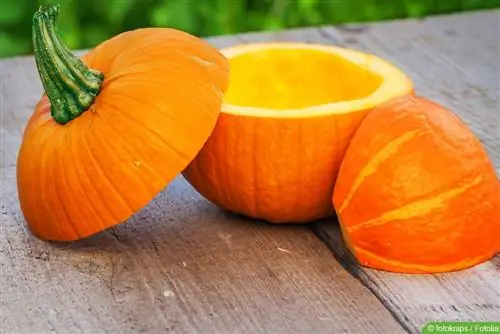
The be-all and end-all for deep freezing without the formation of bitter substances is the air seal. Air or oxygen drives ripening. If the taste test is negative and therefore no bitter substances can be tasted, the state of ripeness and thus the chance of increased bitter substance formation can increase quickly through oxygen supply. The only thing that helps here is an airtight seal - as quickly as possible. This means putting the pumpkin in the cooler, properly packaged, quickly after harvesting or purchasing.
Raw Cucurbita
If you want the autumn fruit to be as fresh and crunchy as possible after freezing/thawing, the best and safest option is to freeze it raw when it is early to harvest. This is particularly recommended if it is to be used as a salad or a crunchy vegetable side dish, for example. It is important that it is cut into small, bite-sized pieces before storing it in the freezer, because if it were cut frozen, it would absorb too much water when thawed and would quickly become mushy if cut while thawed.
This is the ideal way to proceed:
- Peel the peel - with the exception of Hokkaido pumpkins, because the peel can be eaten without any problems
- Cut fruit
- Detach stem base
- The pulp is cut into small pieces
- Remove cores
- Do not blanch as this will result in mushyness
- Be sure to fill the pieces/cubes into freezer bags in portions
- Using vacuum sealing is ideal
- Alternatively, press as much air as possible out of the freezer bag by hand
- Seal freezer bags airtight
Tip:
If you have a shock freezer, you can shock freeze the cubes for two to three hours. This prevents them from sticking together when they are then frozen in the normal freezer.
Pumpkinism
Another way to prevent pumpkins from becoming bitter and to give them a longer shelf life by freezing them is to prepare them into puree. If you want to use it to make pumpkin soup later, this variant is the more ideal option because it shortens the subsequent work and cooking time. Preparation and freezing of puree work as follows:
- Hollow out the pumpkin
- Core the fruit
- Cut off/peel the peel - exception: Hokkaido variety
- Cut into small pieces or cubes
- Fill pot with water, heat and add pieces/cubes
- Steam for about ten minutes until soft consistency
- Drain the water and puree the pieces/cubes
- Then allow to cool and transfer to a suitable freezer container
- Use a freezer container from which the air can be removed
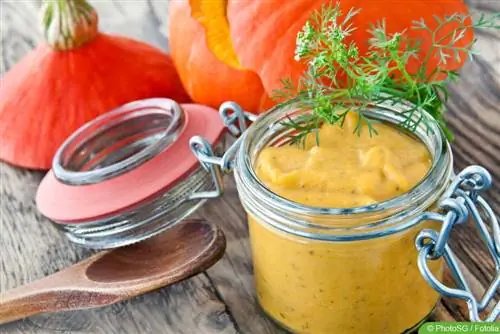
Tip:
Frozen, the pumpkin puree can be easily combined with a martini. Simply cut it into small cubes when frozen and add it to the martini. Thaw them slowly, stirring with a drinking straw. They give the drink a special touch and cool it a la “stirred - not shaken”.
Grate and freeze
For later baking of pumpkin bread, cakes or similar, a pumpkin can also be frozen in a grated state. By rubbing, any bitter substances present lose their connection to the pulp. The chain is broken. During preparation, the shell is also peeled and the seeds removed. Smaller pieces should also be cut. Since they then have to be rasped, they can be larger so that they fit better in the hand and can be guided over the rasp. Pack it in a reasonably airtight container and the pumpkin rasps are ready for freezing. If the usage plans change and a pumpkin soup is preferred, the rasps are simply pureed after defrosting and used as normal to prepare the pumpkin soup.
Durability
Freezing provides a significantly longer shelf life for pumpkins. While these only stay fresh for three to four weeks in the refrigerator between ten and 13 degrees Celsius, depending on the degree of ripeness, their shelf life can be extended by a few months in the freezer. When cut, the shelf life is reduced to a maximum of one week, provided that the pumpkin fruit is covered with cling film in a somewhat airtight manner. That's why it's worth freezing leftovers if you can't eat them within a short period of time.

